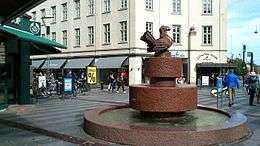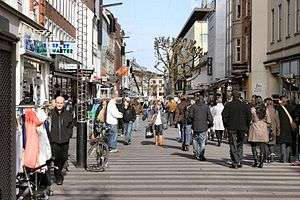Søndergade, Aarhus
| Søndergade or Strøget | |
|
Søndergade | |
| Length | 350 m (1,150 ft) |
|---|---|
| Location | Town Center, Aarhus, Denmark |
| Postal code | 8000 |
| Coordinates | 56°09′15.1″N 10°12′23.2″E / 56.154194°N 10.206444°E |

Søndergade or Strøget is a 350-meter-long street in Aarhus, Denmark. It is located in the central Town Center neighborhood and runs south to north from Ryesgade to Skt. Clemens Stræde and provides access to the alleys Telefonsmøgen and Posthussmøgen. Søndergade was created between 1854 and up through the 1860s as the city expanded southwards following the abolition of octroi and the city walls. The word Sønder is an older Danish form of "south" and the name thus means "South-street".[1] Søndergade is part of the 750 meters long pedestrian zone Strøget which runs from Aarhus Central Station to Aarhus Cathedral, consisting of the three streets Søndergade, St. Clemens Street and Ryesgade. Strøget has about 47.000 visitors on a daily basis and some 14 million visitors annually, making it among the busiest commercial streets in Denmark.[2]
History
In 1851 octroi was abolished in Denmark and tolls were no longer collected at the city limits of the market towns, including Aarhus. The walls and city gates were subsequently dismantled and the city had more freedom to grow.[3] The industrialization taking place in the 19th century resulted in a rapid population boom and the city gradually expanded onto the surrounding farmland. Most of Aarhus was at the time situated north of the Aarhus River although some limited development had taken place along the south shore. The southern boundary of the city was marked by what is today the alleyways Telefonsmøgen and Posthussmøgen which at the time had been toll stations.[4]
The merchant Henrik Schandorff owned the land immediately south of the city and in 1854 he petitioned the city council for permission to parcel the land off and construct new streets.[5][6] The city council approved the proposal but demanded the primary, central street in the new neighborhood be 12.5 metres [41 ft] wide which was considerable at the time.[7] The initial development happened gradually and the new street was not fully built up until the late 1860s largely due to the fact that it was a dead end street ending at the river in a steep hill.[8] In order to get to the center of the city from the railway station by carriage or tram it was necessary to move along Skolegade and use the bridge Mindebro while going through Søndergade was only possible for pedestrians and then required a significant detour.[9][10] In 1884 the bridge Skt. Clemens Bro was constructed in Søndergade, effectively lengthening it and making it, along with Ryesgade, a direct route from the Central Railway Station to the central square Store Torv and the cathedral.[11]
The opening of Skt. Clemens Bro made Søndergade into the premier commercial street in the city, connecting the old neighborhoods north of the river to the newer developments, such as Frederiksbjerg, south of the river.[12][13] Several buildings constructed in the 1850s were demolished in favor of larger structures that could accommodate the need for larger businesses.[14] In 1904 The first electrical tram lines were built to run through Ryesgade and Søndergade and in 1929 it was widened to a double line.[15][16] In 1972, on 7 November, Søndergade was pedestrianized, the tram lines removed and new paving stones, street lights, benches, trees and phone booths put in while heating was installed under the street to keep it snow-free during winter. 30 years later in 2001-02 the paving was replaced again and the pedestrian zone expanded to include Ryesgade.
In 1944 an act of Schalburgtage carried out by the Peter group demolished a number of buildings in Søndergade in 5-6 explosions. The destroyed buildings were Søndergade 1A, 29, 47, 49, 58 and 60 with the first building hit being Ankerhus that burned down and was never rebuilt. The first explosion occurred at 1.20 in the night and the rescue operations were underway when the other bombs went of.
Structures
The first parcel of land sold in 1954 went to Søren Frich who established his factory Frichs there before it moved to Åbyhøj.[17] In 1919 the factory was removed and the prominent building Regina was built in its place. The Regina building was a central event venue, hotel and cinema in the city for many years.[18] Today it is home to many different stores and a restaurant. The large department store Salling is located in Søndergade and there is a sculpture and fountain by the sculptor Erik Heide named Fugl med Guldæble (Bird with Gold Apple) close by.
References
- ↑ "Søndergade" (in Danish). Aarhus City Archives. Archived from the original on 18 December 2016. Retrieved 18 December 2016.
- ↑ "Strøget" (in Danish). Aarhus Strøg Association. Archived from the original on 18 December 2016. Retrieved 18 December 2016.
- ↑ Sejr 1960, p. 117, line 11: "Dengang, dvs. fsr 1850 , da konsumptionen ophævedes, skulle nemlig alle fødevarer m.m.) som bragtcs ind i byen, gennem byportenc, hvor tolderne kunne kontrollere dem og afkræve behørig accise eller konsumptionsafgift."
- ↑ Sejr 1960, p. 117, line 8: "den daværende bebyggelse er den dag i dag tydeligt markerede i Posthussmøgen og den tilsvarende smøge, Posthussmøgen"
- ↑ Sejr 1960, p. 117, line 4: "...omkring 1850 henlå terranet mellem Frederiksgade og Fredensgade ganske ubebygget. På denne mark, der tilhørte kobmand Hendrik Schandorff..."
- ↑ Sejr 1960, p. 118, line 2: "I foråret 1B54 indrykkede han (Schandorff) en annonce i Aarhuus Stiftstidende om salg af grunde. Det var egentlig begyndelsen til både Søndergade og Østergade."
- ↑ Sejr 1960, p. 118, line 9: "...tværtimod forlangte byrådet senere, at hvis Schandorff lavede nye gader, skulle de være mindst 20 alen brede..."
- ↑ Sejr 1960, p. 121, line 8: "Mod nord mundede den med en temmelig stejl skråning ud i Fiskergade."
- ↑ Sejr 1960, p. 122, line 6: "Trafikken fra banegården gik derfor ad Fredensgade over Mindebro og gennem Skolegade til torvene, som stadig var byens centrum."
- ↑ Sejr 1960, p. 122, line 10: "For at komme til torvene fra Søndergade skulle man altså først ind ad skråningen ti1 Fiskergade, derefter over en smal bro for gående til Ågade, og derfra ad >Stentrappen< op til Sct. Clemcnsstræde"
- ↑ Sejr 1960, p. 122, line 19: "I 1870ernc anlagdcs Ryesgadc over gartner Jensens have, hvorved Søndergadc fik direkte forbindclse med banegården, og i 1884 åbnedes Sct. Clemens Bro"
- ↑ Sejr 1960, p. 122, line 24: "...trafikken samlede sig i Ryesgade-Søndergade, der nu naturligt optog hele færdslen fra banegården og tilligc blev hovedforbindelsen mellem den gamle by og den store, hurtigt voksende nye bydel Frederiksbjerg."
- ↑ Sejr 1960, p. 122, line 26: "Nybyggergaden på Schandorffs toft var pludselig blevet en travl hovedgade, og i løbet af få år blev den tillige en af byens fornemste forretningsgader."
- ↑ Sejr 1960, p. 123, line 19: "I begyndelsen kneb det for Søndergade at illudere som strøg; de mange små huse, der var bygget i 1B6oerne og 1870erne, kunne ikkc rigtigt honorere kravene til forretningslokaler"
- ↑ Sejr 1960, p. 123, line 4: "i 1904 kom endelig den elektriske sporvogn,"
- ↑ Sejr 1960, p. 123, line 9: "Efter at kommunen i 1929 havde overtaget sporvognen, blev der imidlertid hurtigt gennemfort dobbeltspor"
- ↑ Sejr 1960, p. 119, line 3: "Schandorff havde straks solgt den store grund på hjørnet af Sønder A11é og Søndergade til en ung, energisk mand ved navn Søren Frichs."
- ↑ Sejr 1960, p. 120, line 7: "Akts. Frich. Fabriker flyttede til Abyhøj, hvorefter Akts. Fotorama på den ledige grund opførte det nuvrærende store Regina-kompleks,"
- Publications
- Sejr, Emanuel (1960). Gamle Århusgader - Første samling. Århus Byhistoriske Udvalg. ISBN 87-504-0353-2.
- Weinreich, Mogens (2007). Kend din by II. Østjysk Hjemstavnsforening. ISBN 978-8-79856-816-2.
External links
| Wikimedia Commons has media related to Søndergade. |
Coordinates: 56°09′31″N 10°12′37″E / 56.1586°N 10.2104°E

